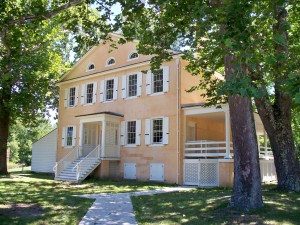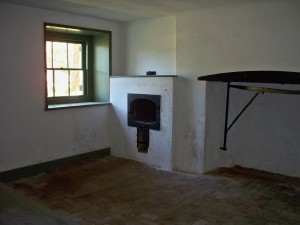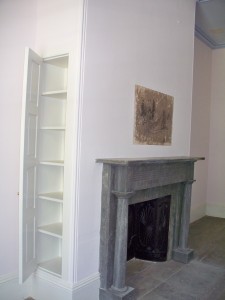This is part two of a three part series looking at the history of the ghost town of Atsion. You can find part one at this link.
Samuel Richards, good-looking and enormously successful, was the only member of the family to surpass his father’s success in business. He was born on May 8, 1769 near Warwick Furnace in Pennsylvania where his father was apprenticed into the iron trade. The year prior to Samuel’s birth, William Richards began working at the newly constructed Batsto Furnace.
Samuel was fifteen years old when his father acquired ownership of Batsto. There he quickly learned the iron trade and, in six or seven years, was representing the furnace at the family store in Philadelphia. He often wrote to his father offering advice and making observations about the quality of the iron when it wasn’t up to his standards. In October of 1794 he wrote, “the old Iron that is upon hand is very rusty which hurts the sale… I have mixed a good deal of it with the new and worked it off that way.”
He was to marry twice, both times to attractive, rich widows. His first wife was Mary Smith Morgan. They were married on November 18, 1797 at the home of her father, the wealthy Philadelphia merchant William T. Smith, also known as “Old Silver Heels.” The Richards had four children, all of which died between 1799 and 1803. They had four more children, three of which survived to adulthood: Thomas Smith, Sarah Ball, and Elizabeth Ann Richards. Their mother passed away on May 3, 1820 at the age of 50. The marriage, which lasted 23 years, is said to have been congenial and happy, despite the loss of so many children.
Samuel purchased a half interest in Atsion in 1819. With this purchase he controlled a network of ironworks that would have made Charles Read envious. Besides his interest in Atsion he also owned Weymouth Furnace, Speedwell Furnace, and had a partnership in Martha Furnace with Joseph Ball. On June 19, 1819 the old furnace at Atsion went back into blast under the management of John Richards, Samuel’s cousin, to fill an order for water pipes for the city of Philadelphia. The furnace was allowed to go out of blast after the pipes were finished and Richards put his share of Atsion up for sale shortly afterwards, perhaps due to a lack of orders or difficulties in the partnership with Henry Drinker. The buildings slowly deteriorated as the furnace sat idle and the workmen departed for opportunities elsewhere.
On October 8, 1822 Richards married his second wife, Anna Maria Martin Witherspoon. By all accounts the charming woman was a perfect compliment to her new husband’s personality. They made their home at 347 Arch Street in Philadelphia, just a few blocks away from the house Samuel had shared with his widow. They had three children, two of which survived to adulthood: Maria Lawrence and William Henry.
Perhaps showing his tenacity or business acumen, Richards purchased Drinker’s half share of Atsion in 1824. Now the sole owner, he embarked on a massive project to rebuild the town. One of the first buildings he built was a modern blast furnace that utilized the latest improvements in iron making technology – the hot blast method. By pre-heating the air that would be blasted into the furnace (hence the name) it was found that fuel consumption would be considerably reduced. This led to a reduction in the cost to produce iron as there was less charcoal required per ton of production, as well as a reduction in the number of trees needing to be felled by the colliers.

In 1826 the Richards built a large and expensive mansion at Atsion, replacing the old dilapidated Lawrence Saltar mansion. This fourteen-roomed house, built in the Greek revival style, still stands today as a testament to the past importance of this furnace town. Iron products adorned the exterior of the building: drain spouts, emblazoned 1826, hang at each corner of the building; cast iron windowsills; and thirteen cast iron columns (manufactured at Weymouth Furnace originally as water pipe for the city of Philadelphia) support the roof of the porch that wraps around two sides of the building. Inside there are two main stories, a ground level basement kitchen with a brick stove and oven, and an attic where the domestic servants resided.


The first story had four rooms flanking a center hall with doors at each end. Two large parlors are on the west side of the house, facing Atsion Lake, and are connected by a large sliding door that could be opened to create a large ballroom. Contemporaries noted that the Richards held a lavish party to celebrate the construction of the mansion and this ballroom would certainly have been the hub of social activity in the house. Across the hall was a formal dining room and preparation kitchen, with meals being cooked in the stove and ovens in the basement, and brought up by servants via a special staircase. The second floor contained four bedrooms for the Richards family. Special slatted doors offered ventilation – important in the blustery summer months – although the house was built four fireplaces – each with a cast iron fireback and marble mantle – for heat in the colder months.
The next year a company store was built adjacent to the mansion. This store not only offered foodstuffs and other products for Atsion’s employees but also, by 1832, housed the post office that had moved back from Sooy’s Inn at Washington. Samuel Richards himself held the title of postmaster for many years. This store stayed open, through a succession of owners, until 1946. Today it serves as a ranger station for Wharton State Forest. The final building from the Richards era, a church, was erected in 1828. The deed for it states that “Samuel Richards, with a view and desire to promote Christian Knowledge, has erected a house for religious worship at Atsion… and, in order that the said house may at all times hereafter be held for that purpose and the lot of ground on which the same is built and erected may forever be held as a side for a house of religious worship and for a burial place.”
Times were prosperous in Atsion. Thomas Gordon, in his Gazetteer of the State of New Jersey, tells of the size and scope of the works at Atsion in 1834:
Atsion, post-town and furnace, on the Atsion River, partly in Galloway Township, Gloucester County, probably in Washington Township, Burlington County, 9 miles above the head of navigation, 12 miles from Medford, 17 from Mount Holly, on the road leading to Tuckerton, and 57 from Trenton. Besides the furnace, there are here, a forge, gristmill, and three sawmills. The furnace makes from 800 to 900 tons of casting, and the forge from 150 to 200 tons of bar iron annually. This estate, belonging to Samuel Richards, Esq., embraces what was formerly called Hampton furnace and forge, and West’s Mills, and contains about 60,000 acres of land. There are about 100 men employed here, and between 6 and 700 persons depending for sustenance upon the works.
Considering that Atsion was nearly in ruins fifteen years earlier, it’s clear that the town prospered under Samuel’s leadership. Compared to Batsto and Martha Furnace that each, according to Gordon, employed 60-70 men and had only 400 people living there, Atsion was one of the largest iron enterprises in South Jersey at the time.
During Samuel’s later years he began to turn the day-to-day operation of Weymouth Furnace to his son-in-law Stephen Colwell, a Philadelphia attorney who married Sarah, his daughter from his first marriage. It appears that Samuel managed Atsion until his death on January 4, 1842. He died an incredibly wealthy man, and his children and widow were well taken care of in his will. Weymouth was divided equally between Sarah and Elizabeth Ann, and Atsion between Maria and William. Martha Furnace was sold to its long time manager Jesse Evans.
Ironworks in Pennsylvania began experimenting with fuelling their furnaces with anthracite coal around the time of Samuel’s death. Anthracite coal was easier to obtain, cheap to purchase, and was located close to the iron mines in Pennsylvania. By the end of the 1840’s the bog iron furnaces in south Jersey were hopelessly outclassed by their Pennsylvanian rivals and it is doubtful that even an ironmaster as skilled as Samuel Richards, much less his inexperienced children, could have kept a charcoal fuelled furnace profitable.
Maria met William Walton Fleming, owner of the W.W. Fleming Cobalt and Nickel Works in Camden, at a party at Weymouth in 1848. On June 14, 1849 they married and took up residence in the Atsion mansion as well as the Richards’ family home on Arch Street in Philadelphia. Perhaps encouraged by the successful paper mill at nearby McCartyville (later known as Harrisville) he and two business partners, Walter Dwight Bell and Albert W. Markley constructed a paper mill at Atsion on or near the site of the furnace. The mill was described in a legal complaint dated April 1855:
The said building is a stone mill erected for the manufacture of paper. The main building is two stories high about sixty feet long by fifty feet deep, and attached thereto and making a part thereof are a boiler and bleach house, forty-two feet by thirty-two, a machine house eighty feet by twenty-four, a water wheel and a wheel house, twenty-eight feet by twenty-four.
It appears that the mill only operated for a short time, or perhaps not even at all. Fleming, like many other businessmen in the northeast in the mid 1850’s, was in dire financial straits. He lost a considerable amount of money on an investment in the Camden & Atlantic City Railroad, which by virtue of him being a member of the board of directors, allowed him to borrow heavily. On September 11, 1854 he assigned his assets to trustees “for the protection of his creditors.” He named his partners in the paper mill venture, Bell and Markley, as well as his father, Thomas Fleming and brother-in-law Stephen Cowell as his trustees. Interestingly neither the senior Fleming nor Cowell wanted nothing to do with the mess and refused to serve.
Facing a long list of creditors, legal charges filed by his father, and over a half-million dollars in debt, Fleming took a page from Charles Read’s playbook and fled the country. For over a year nobody in the family knew where he had gone. Left alone to face his angry creditors, his wife Maria dipped into her own inheritance to repay Thomas Fleming. Amazingly enough she was able to locate Fleming in Brussels, Belgium where, after a reconciliation, she and their son reunited and made a house at 15 Boulevard du Regent. Shortly thereafter Samuel Richards’ widow Anna Maria joined them. There in Europe they were able to live out their rest of their lives in comfort and happiness, supported by the money left by Samuel Richards.
William Henry Richards, brother of Mary, was fourteen when his father died. Surrounded by so much wealth, he never had to work and never developed any of the business sense that his father and grandfather had been famous for. The Atsion record books show him to have been married to Mary Thorne on April 29, 1850, although other sources show that he was unmarried. The union seemed to be a rocky one and Mary Thorne eventually left and settled in nearby Vincentown. The two had a daughter, Anna Maria, named after William’s mother. By age two she was living with, and being cared for, by her grandmother, eventually moving to Belgium to be with the her grandmother and the Flemings. After the auction of the Atsion property William spent his remaining years tilling soil on a farm he purchased along the Tuckerton Stage Road.
The Atsion property went to auction on April 7, 1859. According to the West Jerseyman, this “was the largest public sale of Real Estate which has probably ever been made in this section of New Jersey.” The account of the auction continued:
The extent and value the property, the widespread and diversified interests involved by the transactions of its late owner, served to draw together a concourse of Brokers, Bankers, Real Estate Operators, Lawyers, Speculators and Capitalists, more in keeping with the Rotunda of the Exchange than the quiet parlors of a Country hotel. [The auction was held at the West Jersey Hotel.] Presently the “frosty pow” of Mr. Thomas, whose head is silvered o’er in the service of the fatal hammer, was observed to ride amid the crowd, and announce that “Atsion”, its mansion, its mills, its buildings and broad acres, were positively to be sold, without reserve, to the highest bidder. The terms of payment were stated, the same to be made subject to a mortgage of seventy-five thousand dollars. An awful pause ensued, during which the good looking company looked around for the brave man who would bventure a bid upon it. He turned up in good time, however, with a bid of $5000, when the bidding went on spiritedly, at $1000 a bid, between two gentlemen only, till it reached the sum of $33,000 when the veteran auctioneer took a breath, and resumed, with a little professional expatiation, which produced another bid, when the property was knocked down to M. NEWKIRK, Esq. for the sum of $33,500 which, including the cost of the mortgage of $75,000, will bring the cost of the whole 28,000 acres to the round sum of $111,500. [The math reported here is obviously wrong – the total cost of the Atsion property would have been $108,500, still not a particular bargain.]
No deed is recorded to Newkirk who likely realized that he had overpaid and found some way to extricate himself from the deal, legally or otherwise. Atsion was unsuccessfully auctioned on January 3, 1860 and again on January 31. Finally, on April 13, 1861, the property was sold to Jarvis Mason, of Philadelphia for $66,000. Mason held the property for one year before selling it to Colonel William Patterson of Philadelphia, for $82,500, on July 11, 1862.
In the final installment of this series, we’ll trace the history of Atsion through a name change, the coming of the railroad, another mill, and on to modern times.
Photographs courtesy of Terry Schmidt.
